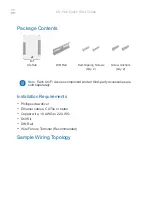Analog-to-Digital Converter (S08ADC12V1)
MC9S08QL8 MCU Series Reference Manual, Rev. 1
NXP Semiconductors
135
10.4
Functional Description
The ADC module is disabled during reset or when the ADCH bits are all high. The module is idle when a
conversion has completed and another conversion has not been initiated. When idle, the module is in its
lowest power state.
The ADC can perform an analog-to-digital conversion on any of the software selectable channels. In 12-bit
and 10-bit mode, the selected channel voltage is converted by a successive approximation algorithm into
a 12-bit digital result. In 8-bit mode, the selected channel voltage is converted by a successive
approximation algorithm into a 9-bit digital result.
When the conversion is completed, the result is placed in the data registers (ADCRH and ADCRL). In
10-bit mode, the result is rounded to 10 bits and placed in the data registers (ADCRH and ADCRL). In
8-bit mode, the result is rounded to 8 bits and placed in ADCRL. The conversion complete flag (COCO)
is then set and an interrupt is generated if the conversion complete interrupt has been enabled (AIEN = 1).
The ADC module has the capability of automatically comparing the result of a conversion with the
contents of its compare registers. The compare function is enabled by setting the ACFE bit and operates
with any of the conversion modes and configurations.
10.4.1
Clock Select and Divide Control
One of four clock sources can be selected as the clock source for the ADC module. This clock source is
then divided by a configurable value to generate the input clock to the converter (ADCK). The clock is
selected from one of the following sources by means of the ADICLK bits.
•
The bus clock, which is equal to the frequency at which software is executed. This is the default
selection following reset.
•
The bus clock divided by two. For higher bus clock rates, this allows a maximum divide by 16 of
the bus clock.
•
ALTCLK, as defined for this MCU (See module section introduction).
•
The asynchronous clock (ADACK). This clock is generated from a clock source within the ADC
module. When selected as the clock source, this clock remains active while the MCU is in wait or
stop3 mode and allows conversions in these modes for lower noise operation.
Whichever clock is selected, its frequency must fall within the specified frequency range for ADCK. If the
available clocks are too slow, the ADC do not perform according to specifications. If the available clocks
1
ADPC17
ADC Pin Control 17. ADPC17 controls the pin associated with channel AD17.
0 AD17 pin I/O control enabled
1 AD17 pin I/O control disabled
0
ADPC16
ADC Pin Control 16. ADPC16 controls the pin associated with channel AD16.
0 AD16 pin I/O control enabled
1 AD16 pin I/O control disabled
Table 10-12. APCTL3 Register Field Descriptions (continued)
Field
Description
Summary of Contents for MC9S08QL4
Page 4: ...MC9S08QL8 MCU Series Reference Manual Rev 1 4 NXP Semiconductors...
Page 36: ...Chapter 3 Modes of Operation MC9S08QL8 MCU Series Reference Manual Rev 1 36 NXP Semiconductors...
Page 56: ...Chapter 4 Memory MC9S08QL8 MCU Series Reference Manual Rev 1 56 NXP Semiconductors...
Page 172: ...Modulo Timer S08MTIMV1 MC9S08QL8 MCU Series Reference Manual Rev 1 172 NXP Semiconductors...
Page 238: ...Development Support MC9S08QL8 MCU Series Reference Manual Rev 1 238 NXP Semiconductors...
Page 239: ......


















